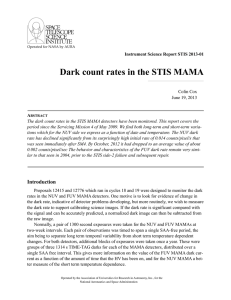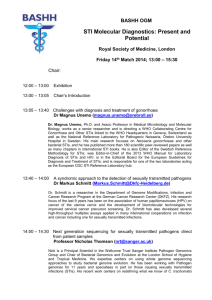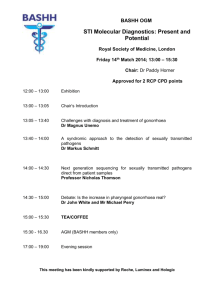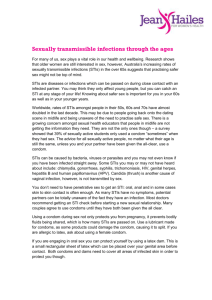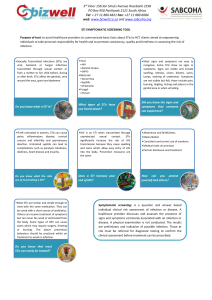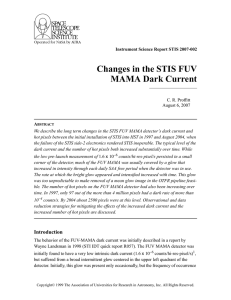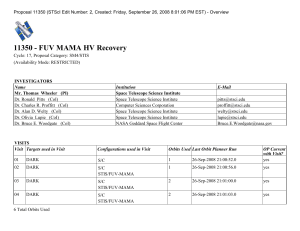Dark count rates in the STIS FUV MAMA
advertisement
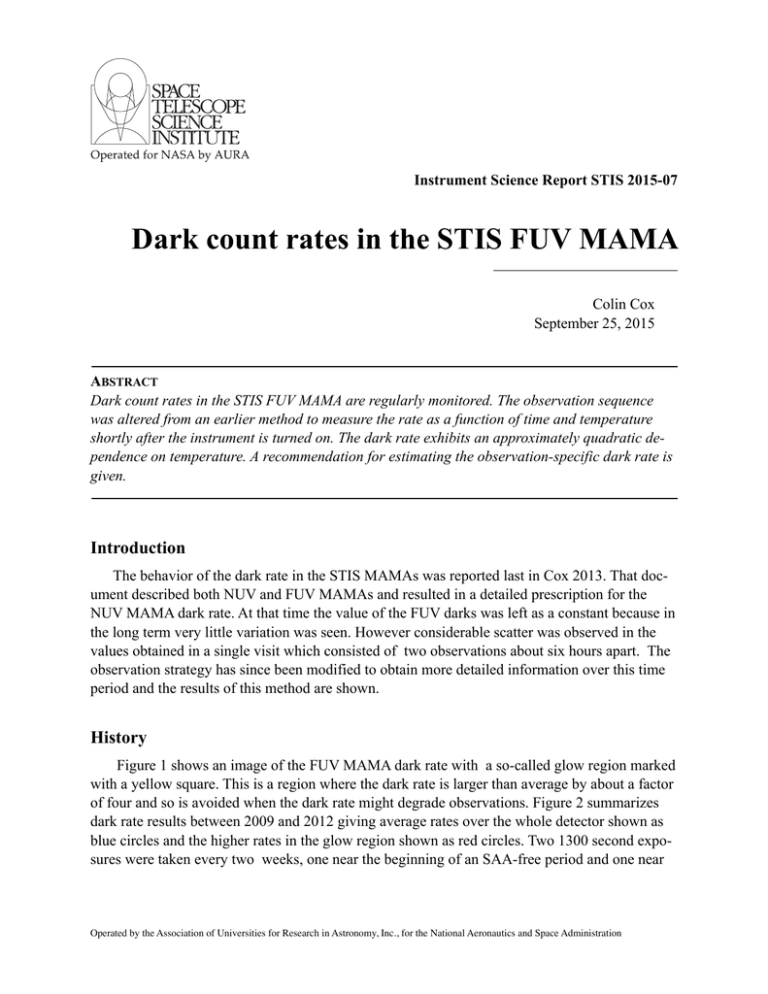
Instrument Science Report STIS 2015-07 Dark count rates in the STIS FUV MAMA ! Colin Cox September 25, 2015 ! ABSTRACT Dark count rates in the STIS FUV MAMA are regularly monitored. The observation sequence was altered from an earlier method to measure the rate as a function of time and temperature shortly after the instrument is turned on. The dark rate exhibits an approximately quadratic dependence on temperature. A recommendation for estimating the observation-specific dark rate is given. ! Introduction The behavior of the dark rate in the STIS MAMAs was reported last in Cox 2013. That document described both NUV and FUV MAMAs and resulted in a detailed prescription for the NUV MAMA dark rate. At that time the value of the FUV darks was left as a constant because in the long term very little variation was seen. However considerable scatter was observed in the values obtained in a single visit which consisted of two observations about six hours apart. The observation strategy has since been modified to obtain more detailed information over this time period and the results of this method are shown. History Figure 1 shows an image of the FUV MAMA dark rate with a so-called glow region marked with a yellow square. This is a region where the dark rate is larger than average by about a factor of four and so is avoided when the dark rate might degrade observations. Figure 2 summarizes dark rate results between 2009 and 2012 giving average rates over the whole detector shown as blue circles and the higher rates in the glow region shown as red circles. Two 1300 second exposures were taken every two weeks, one near the beginning of an SAA-free period and one near Operated by the Association of Universities for Research in Astronomy, Inc., for the National Aeronautics and Space Administration Instrument Science Report STIS 2015-XX Figure 1: Dark rate image. Designated glow region is indicated by the yellow square the end of the same period, about six hours later. Considering just the whole detector values, it can be seen that at each visit we measure a value near 10-5 counts per pixel per second and one near 10-4. These correspond to the beginning and end of each bi-weekly visit. Although the detector output is binned in a 2048 by 2048 array we report the results as on a 1024 by 1024 array which simply means multiplying the measured count rates by 4.With a factor of ten difference in the values it becomes of interest to find what happens between these times. Consequently in proposal 13146 for cycle 20 we changed the strategy to measure the dark rate at six equally spaced intervals over a six hour period during which time the STIS MAMAs have their high voltages turned on. Normally these would be turned off. To accomplish this without increasing the number of orbits for the proposal we only performed the measurements every six weeks. This strategy has been continued in subsequent proposals. Instrument Science Report STIS 2015-07 Page 2! Instrument Science Report STIS 2015-XX Figure 2: FUV MAMA dark rates measured following SM4 until October 2012. Average rates in blue and enhanced rates in the glow region in red are shown. There are measurements at the start and end of each visit. Figure 3: FUV MAMA dark rate results since December 2012. There are six measurements at each visit. Instrument Science Report STIS 2015-07 Page 3! Instrument Science Report STIS 2015-XX Figure 4: FUV MAMA count rates as a function of time since turn-on for two separate visits. Figure 3 shows the results from the end of 2012 to May 2015 illustrating that there are now six measurements at each visit spaced at six week intervals. As before we see no long-term trend and we are mainly interested in the variation within a visit. First we study the dependence on the time from the beginning of the first exposure which normally corresponds to when the high voltage is turned on, depending on what other STIS measurements have taken place. Since the dark rate study takes up almost the full SAA-free period it is unlikely that other measurements occur close to this. Figure 4 shows the dark rate against the time since high voltage turn on for two visits. The increased rate with time turned on is clear but different visits show somewhat different values. In an attempt to better characterize the dark rate behavior ,which we expect to be temperature dependent, we make use of two values captured in the image header named OM1CAT and OM2CAT which are the temperatures at two charge amplifier positions, both of which are close to the detector. Fitting the dark rates to quadratic functions works well with RMS deviations of 3.4×10-6 and 7.5×10-7 counts/pixel/sec for OM1 and OM2 respectively. Results and recommendations Figure 5 shows the temperature dependent results for a typical visit. Also indicated are the results of fitting a the dark rate with a quadratic function of temperature. Although no theoretical basis is suggested, the fits are quite good with RMS deviations of 3.7×10-6 and 7.5×10-7 for OM1 and OM2 and explained percentages of the RMS deviation of 88.5% and 97.7%. Attempts to fit the aggregate results are less successful in that the behavior at different visits is not identical. Figures 6,7 and 8 show the results of fitting all the data against time turned on and the amplifier temperatures. Instrument Science Report STIS 2015-07 Page 4! Instrument Science Report STIS 2015-XX Figure 5: Dark rates vs two temperatures with quadratic fits for a single visit. Figure 6: Comparison with dark rates vs time on for the full data collection. Although the quadratic fit follows data trend therePage are 5! large deviations. Instrument Science the Report STIS 2015-07 Instrument Science Report STIS 2015-XX Figure 7: Dark count rate as a function of the temperature OM1 using all the data Figure 8: Dark count rate as a function of the temperature OM2 using all the data Instrument Science Report STIS 2015-07 Page 6! Instrument Science Report STIS 2015-XX As with the time on prescription the behavior is not identical from visit to visit. The aggregate plots show attempts to fit quadratic functions to the full collection of data from August 2009 to the present. Only the OM1 fit appears reasonable with an RMS deviation of 2.3×10-5 counts/ pixel/second. Examining the graph shows that using a value derived from the fit would usually match the true value to within a factor of two. The green line is the quadratic function rate = [1.26 - 1.71(T-35) + 4.88(T-35)2]×10-6 counts/pixel/second where T is the temperature in degrees Celsius read from the OM1CAT keyword. The current value for the FUV dark rate used in the Exposure Time Calculator is 1.5×10-4 counts per pixel per second. This is a conservative value designed to dissuade observers from attempting a measurement that might be significantly degraded by the dark rate. However for normal observations, nearly all of which take place within two hours of high voltage turn-on, the rate is typically close to 3×10-5, about five times lower, although a value twice as large cannot be ruled out. A 1000 second exposure taken within two hours of the high voltage turn-on would have a dark count of about 3×10-2 counts/pixel, meaning that only three pixels in a hundred would have a single dark count. For critical analysis it would be useful to use the above prescription based on the OM1CAT value. For temperatures below 35ºC the constant value 1.26 ×10-6 would be appropriate. Overall it should be noted that these dark rates are exceedingly low and in many cases can be ignored altogether. It is difficult to see how these results can be applied in a corrective manner and there is no temperature control. They are probably of more use in planning observations. For observations which are extremely dark rate limited the first step would be to avoid the glow region. Also it is possible to request that an observation take place soon after high voltage turn-on although there is no automatic way of ensuring this. Such requests should only be made when really necessary. References Cox,C., Dark count rates in the STIS MAMA , Instrument Science Report STIS 2013-01, June 2013 Instrument Science Report STIS 2015-07 Page 7!

